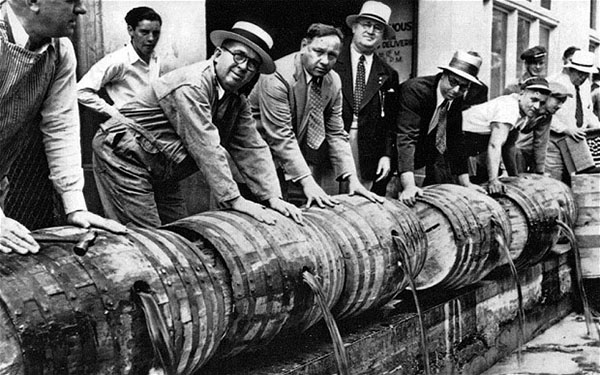The passage of the 18th Amendment in 1920 ushered in an era of high crime, increased alcohol fatalities, and cheap, adulterated booze.
In the roughly thirteen years between the onset of Prohibition and its repeal, the hopes of reformers wishing to stem the tide of alcoholism in the United States would be bitterly dashed in a hail of mob gunfire and the swirls of deadly hooch served up by illegal speakeasies. In New York City alone, the Prohibition years saw an enormous increase in alcohol-related deaths as drinkers who might have earlier quaffed only a few beers were instead compelled to order up vile concoctions that were as high as 120 proof, adulterated with numerous poisons, and carrying the very real possibility of killing the drinker.
The Noble Experiment
Prohibition, also known as the Volstead Act or the Noble Experiment, became law in January 1920 after being approved by the requisite 36 states, and was almost immediately subverted at every possible turn. It is estimated that by a mere five years after the passage of the law, there were between 30,000 and 100,000 speakeasies operating just in New York City.
Poisonous Alcohol Cocktails
The liquor served up at these clandestine bars was something of a mixed bag. Since drinkable ethyl alcohol was rendered illegal and therefore difficult to come by, bootleggers and speakeasy owners often brewed their own nasty cocktails using industrial-grade alcohols, particularly highly poisonous wood or methyl alcohol, which killed drinkers with frightening regularity. Other harmful substances appeared in bar patrons’ glasses as well, including creosote, formaldehyde, gasoline, chloroform, acetone, and benzene.
The Government Gets Into the Act
In 1926, chemists working for the government actually attempted to make the deadly booze being served in speakeasies more deadly still by adulterating it further. It was hoped that this action would deter people from drinking, since the Volstead Act was clearly not having the effect that was intended. This rather alarming policy backfired spectacularly; not only did people continue to drink their booze no matter how revolting or spiked with poisons it was, but they drank even more alcohol than they had before Prohibition had been enacted.
The Death Toll Mounts
The same year that the government was attempting its own chemical deterrents, the death toll from the industrial alcohol cocktails was rising. About four hundred people died in New York City in 1926 alone, plus another 1,200 who were merely sickened or blinded by the concoctions. The following year saw the death toll rise to 700.
Opinion was divided on what should be done. On one side were those who felt that drinkers who were willing to flout the law and swill down glasses of unknown substances in shady bars got exactly what they deserved. The other side, which included New York City chief medical examiner Charles Norris, felt that the government was complicit in murder by adulterating the liquor and not doing more to warn people of the dangers.
Prohibition Repealed
Whatever the opinion on both sides, however, it was soon clear to almost everyone that the Noble Experiment was a failure. Drinkers, far from being deterred, were chugging unregulated poison in huge quantities and dropping dead in the streets, and bootlegging served as a massive boon to organized crime syndicates. The newly elected President Franklin Delano Roosevelt, no fan of Prohibition, in 1933 signed an amendment to the 18th Amendment called the Cullen-Harrison Act that allowed light wines and 3.2 beer. Then, in December of the same year, Prohibition was officially repealed by the ratification of the 22nd Amendment.
Source:
- Blum, Deborah (2010). The Poisoner’s Handbook: Murder and the Birth of Forensic Medicine in Jazz Age New York. Penguin Press. ISBN: 9781594202438.








